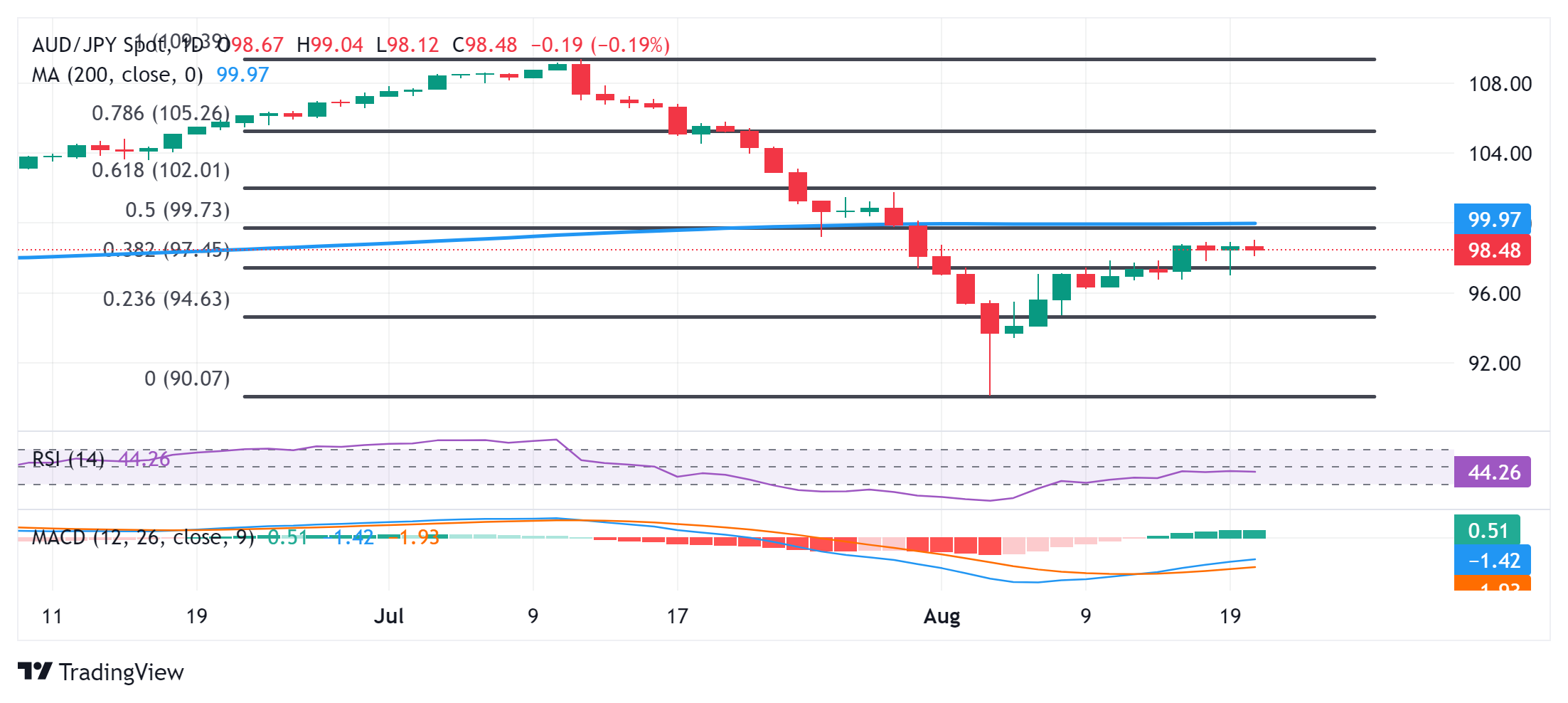- AUD/JPY oscillates in a range below a fresh monthly top touched earlier this Tuesday.
- The mixed technical setup warrants some caution before positioning for further gains.
- A sustained strength beyond the 100 confluence will be seen as a fresh trigger for bulls.
The AUD/JPY cross seesaws between tepid gains/minor losses through the first half of the European session and now seems to have stabilized around mid-98.00s, just below the monthly peak touched earlier this Tuesday.
The Japanese Yen (JPY) continues with its volatile two-way price moves amid domestic political uncertainty, which could hinder the Bank of Japan's (BoJ) plan to steadily lift interest rates from near zero. This, in turn, fails to assist the AUD/JPY cross to build on the overnight modest gains and leads to subdued range-bound price action. That said, the prevalent risk-on mood continues to undermine the safe-haven JPY, which, along with the Reserve Bank of Australia's (RBA) hawkish stance, acts as a tailwind for the currency pair.
From a technical perspective, the AUD/JPY cross is holding comfortably above the 38.2% Fibonacci retracement level of the July-August downfall. This, in turn, supports prospects for an extension of the recent strong recovery from the vicinity of the 90.00 psychological mark, or the lowest level since May 2023 touched earlier this month. That said, mixed oscillators on the daily chart warrant some caution for bullish traders. Hence, any subsequent move up is more likely to remain capped near the 100.00 confluence resistance.
The said handle comprises the very important 200-day Simple Moving Average (SMA) and the 50% Fibo. level, which if cleared decisively will be seen as a fresh trigger for bullish traders. The AUD/JPY cross might then accelerate the positive move towards the 101.00 mark before aiming to test the 102.00-102.10 supply zone or the 61.8% Fibo. level.
On the flip side, the 97.45 area (38.2% Fibo. level) now seems to have emerged as immediate strong support. This is followed by the 97.00 round figure and support near the 96.30-96.25 region. Some follow-through selling below the 96.00 mark might expose the 23.6% Fibo. level, around the 94.65 region, with some intermediate support near the 95.55 horizontal zone and the 95.00 psychological mark.
AUD/JPY daily chart
Bank of Japan FAQs
The Bank of Japan (BoJ) is the Japanese central bank, which sets monetary policy in the country. Its mandate is to issue banknotes and carry out currency and monetary control to ensure price stability, which means an inflation target of around 2%.
The Bank of Japan has embarked in an ultra-loose monetary policy since 2013 in order to stimulate the economy and fuel inflation amid a low-inflationary environment. The bank’s policy is based on Quantitative and Qualitative Easing (QQE), or printing notes to buy assets such as government or corporate bonds to provide liquidity. In 2016, the bank doubled down on its strategy and further loosened policy by first introducing negative interest rates and then directly controlling the yield of its 10-year government bonds.
The Bank’s massive stimulus has caused the Yen to depreciate against its main currency peers. This process has exacerbated more recently due to an increasing policy divergence between the Bank of Japan and other main central banks, which have opted to increase interest rates sharply to fight decades-high levels of inflation. The BoJ’s policy of holding down rates has led to a widening differential with other currencies, dragging down the value of the Yen.
A weaker Yen and the spike in global energy prices have led to an increase in Japanese inflation, which has exceeded the BoJ’s 2% target. With wage inflation becoming a cause of concern, the BoJ looks to move away from ultra loose policy, while trying to avoid slowing the activity too much.
Information on these pages contains forward-looking statements that involve risks and uncertainties. Markets and instruments profiled on this page are for informational purposes only and should not in any way come across as a recommendation to buy or sell in these assets. You should do your own thorough research before making any investment decisions. FXStreet does not in any way guarantee that this information is free from mistakes, errors, or material misstatements. It also does not guarantee that this information is of a timely nature. Investing in Open Markets involves a great deal of risk, including the loss of all or a portion of your investment, as well as emotional distress. All risks, losses and costs associated with investing, including total loss of principal, are your responsibility. The views and opinions expressed in this article are those of the authors and do not necessarily reflect the official policy or position of FXStreet nor its advertisers. The author will not be held responsible for information that is found at the end of links posted on this page.
If not otherwise explicitly mentioned in the body of the article, at the time of writing, the author has no position in any stock mentioned in this article and no business relationship with any company mentioned. The author has not received compensation for writing this article, other than from FXStreet.
FXStreet and the author do not provide personalized recommendations. The author makes no representations as to the accuracy, completeness, or suitability of this information. FXStreet and the author will not be liable for any errors, omissions or any losses, injuries or damages arising from this information and its display or use. Errors and omissions excepted.
The author and FXStreet are not registered investment advisors and nothing in this article is intended to be investment advice.
Recommended content
Editors’ Picks

EUR/USD holds near 1.1350 as markets gear up for this week's big events
EUR/USD keeps its range play intact at around 1.1350 at the beginning of the week. The cautious market mood and easing US Dollar demand help the pair hold its ground as investors gear up for this week's upcoming key macroeconomic data releases.

GBP/USD recaptures 1.3300 as US Dollar buying stalls
GBP/USD stays in positive territory above 1.3300 on Monday. A pause in the US Dollar's advance amid a lack of fresh developments hinting at a further de-escalation of the US-China trade conflict support the pair ahead of this week's critical data releases.

Gold price hangs above $3,265-3,260 support amid receding safe-haven demand and mildly positive USD
Gold price sticks to its bearish bias for the second successive day on Monday and trades just above the $3,265-3,260 pivotal support during the first half of the European session. Despite of mixed signals from the US and China, the optimism over the potential de-escalation of trade tensions between the world's two largest economies turns out to be a key negative factor.

Monero Price Forecast: XMR soars over 50% amid rising demand for privacy coins
Monero (XMR) price is extending its gains by 50% at the time of writing on Monday, following a 9.33% rally the previous week. The main reason for XMR’s rally is speculation that the token, which is widely known for its status as a privacy coin, was used to launder a suspected theft involving 3,520 BTC worth $330.7 million.

Week ahead: US GDP, inflation and jobs in focus amid tariff mess – BoJ meets
Barrage of US data to shed light on US economy as tariff war heats up. GDP, PCE inflation and nonfarm payrolls reports to headline the week. Bank of Japan to hold rates but may downgrade growth outlook. Eurozone and Australian CPI also on the agenda, Canadians go to the polls.

The Best brokers to trade EUR/USD
SPONSORED Discover the top brokers for trading EUR/USD in 2025. Our list features brokers with competitive spreads, fast execution, and powerful platforms. Whether you're a beginner or an expert, find the right partner to navigate the dynamic Forex market.




